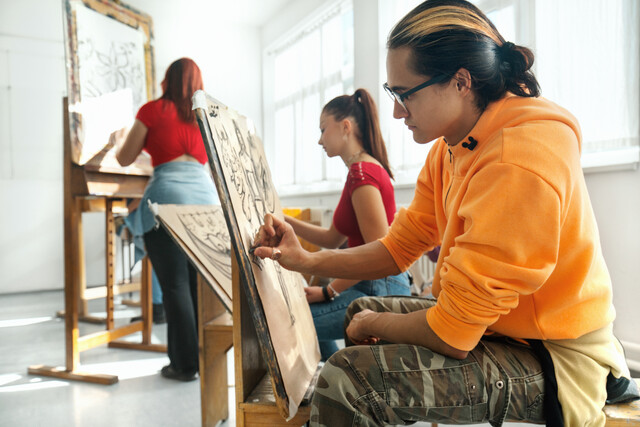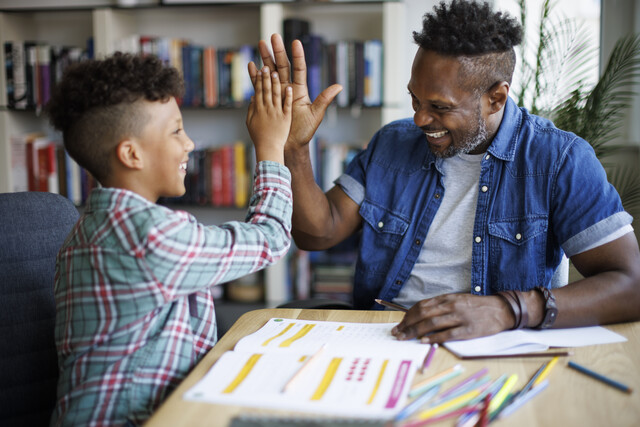Greeting someone you know is a vital part of courtesy and goodwill. All societies have some form of greeting. They are basic to civilized interaction.
The first point about greetings is to do them. It's important to say "hello" even when you feel a bit cranky or shy. It's also important to make introductions even when you're not certain of precisely how it should be done in that situation. Every greeting and introduction is an opportunity to demonstrate respect for others and to create a favorable impression of yourself to others.
Greetings
When you greet someone, you acknowledge their presence. Most people do this automatically and barely notice they're doing it. But failing to offer a greeting to someone you know can easily cause hurt feelings and misunderstandings � you are failing to acknowledge their existence in your presence. Little can be considered more offensive than patently ignoring someone, as this strikes to the heart of the most basic of human needs, inclusion and social interaction.
If someone who usually greets others in a friendly way does not one day, those other people may feel snubbed or think that person is behaving oddly. This can happen for a variety of reasons, such as being preoccupied or distracted, being late for an appointment and rushing, or even forgetting their glasses and not being able to recognize someone they know. Usually these omissions can be corrected with a warm greeting the following occasion, but these omissions illustrate the first essential of manners of good greeting, which is noticing other people.
Informal Greetings
Informal greetings can be verbal, gestured, or both. The most common classic greetings are "hello" and "hi", while "hey" is popular in some regions and with some slices of society. The person's name generally accompanies the "hello", along with a pleasant smile. In some regions, "good morning", "good afternoon", and "good evening" are still common. Children and teenagers have their own greeting norms, which should be discouraged within the general population.
Just because you say "hello" doesn't mean you have to stop and chat. You can still greet someone even if you're in a rush � and if that person wants to stop and talk, just explain your rush with something like, "Hi Lindsey. I wish I had time to chat but I'm on my way to the dentist and running a bit behind." Then part graciously.
Courtesy says you greet people in general, so don't forget to greet those who provide services to you, such as cashiers, salespeople, receptionists, food service workers and hotel/motel employees. When you show good manners, you often receive them in return.
Sometimes the other person is too far away for a verbal greeting, or a verbal greeting would disturb others around you. It is appropriate to smile and nod or wave in public places such as the theater, concert hall or restaurant. Other times, a wave or nod may show lack of attention or distract others, such as during a religious service, lecture, or live performance. In these situations, it's polite to smile and save your greeting for later.
Formal Greetings
Some situations call for a more formal greeting. The verbal greeting is generally the same, "Hello Mr. Johnson" or "How do you do Ms. Lockhart?" The formality of the situation is generally marked by the nonverbal cues accompanying the verbal greeting. In business environments, coworkers may be casual with each other but offer more deference to their boss. In a formal receiving line, even those who know each other well will tend to shake hands or exchange social kisses, offer a polite comment, then move on so as not to hold up the receiving line.
Formal greeting are characterized by first what is said � use "hello" rather than "hi" or certainly "hey". Tone of voice and posture should also be considered. These greetings tend to be rather brief, but should always be pleasant and genuine.
Greetings at Home
Home is the best place to cultivate good greeting manners. Often, people will omit this courtesy, skipping the "good morning" at the start of the day, or welcoming someone home from work or school with only "dinner's ready", "do you have homework?" or "the dog messed in the house again." Only a couple of seconds are required to acknowledge the presence of those we live with. This simple gesture makes life far more pleasant, sets a good example for everyone, and cultivates a habit of greeting others regularly.
Standing?
When you rise to greet someone who has just entered the room, you are demonstrating time-honored respect. You can't always stand though. Sometimes it's difficult, as when you're holding something in your lap, and sometimes it's inconvenient, like when coworkers pop in and out of each other's offices and cubicles.
As a general rule, stand whenever you can. This holds particularly when you're greeting someone older than you, someone you're meeting for the first time, or someone who is traditionally shown social respect such as a religious leader or a person of high social rank.
When hosting a party or other social event, it is customary for hosts and hostesses to rise and greet all arriving guests. But after the party is underway, there's no need to stand every time someone enters the room. When someone leaves the table during a dinner party or restaurant meal, there's no need for the other diners to stand when that person returns.
It's important to evaluate each situation. When standing in a crowded restaurant or theater would disturb other patrons, keep your seat. However, standing and offering your seat to an elderly or infirm person on a crowded bus or train is both courteous and humane.
Rules about men standing while women remain seated have gone away. Today, women often stand and put their hands out when greeting others as well.
Handshakes
The ritual of shaking hands dates at least back to ancient Egypt and Babylon, and possible further than recorded history shows. It was a gesture for men to demonstrate they were not carrying weapons to extend their open right hand. This might explain why women didn't follow the custom until more recently. Today, a handshake represents both welcome and good faith, such as when a deal is sealed with a handshake. People of either sex may first extend their hands.
Within the US, people generally prefer a firm grip � one that is neither barely there nor hurts the other person's hand. They use a perceptible shaking two or three times from the elbow, not the shoulder, but not pumping. Handshakes generally last a few seconds, after which time it's generally best to release your hold if you haven't already felt the other person relax her hand or begin to pull away. If you happen to use a really strong grip, pay attention, and adjust your pressure to what you feel from the other person. Always accompany your handshake with eye contact. If you extend your hand but the other person doesn't, just assume that he or she didn't see your hand, drop it and forget the shake, even though offering your hand is appropriate.
Handshakes are expected when you are introduced to someone new, greet someone entering your home or office, meet someone you know outside of your home or office, see someone to the door, close a business deal or transaction, and leave a function or event.
It's important to pay attention to others, so that you can sense when handshaking is appropriate. It will inconvenience someone with their hands full or who has some sort of infirmity in their hand, arm or shoulder.
Please note that shaking hands is very culturally embedded. Not all cultures follow this tradition as in the U.S. People of many eastern cultures bow to each other in greeting in lieu of a handshake, and refrain from all physical contact when greeting others as an indication of respect for that person. Additionally, even in cultures that do practice shaking hands, a firm grip is often perceived as both aggressive and self-centered, begging the question in the recipient's mind of "why??" In these cultures, a very light and gentle handshake is preferred � they see no need to demonstrate their grip strength to the person they're greeting, and thus remain confused and quite possibly offended when a firm US-style handshake is what they receive. Not adhering to the courtesy codes of the culture in which you find yourself reflects poorly on your own manners as well as those of all of your country people. Also, people of many other cultures often offer social kisses along with the handshake as part of the greeting � in some cultures it's one kiss, usually on the right cheek; in other cultures it's two kisses, one on each cheek, usually right then left; and in yet other cultures it's three kisses, back and forth between cheeks. In some cultures the accompanying kisses are gender-specific, meaning generally they accompany greetings that involve women, but in other cultures, such as some Middle Eastern cultures, these accompanying cheek-kissing practices are only practiced with members of the same sex, be they men or women. Further, when you are greeting someone of a different culture even within US culture, they might anticipate practicing the handshaking and greeting codes of their own cultures. Thus, it's wise to always be aware and observant, paying attention to and following the lead of the foreign people with whom you're interacting so as not to inadvertently confuse or, worse, offend them. This theme will be discussed further in Chapter 12.
Kissing, Hugging, and Other Affectionate Gestures
When family members and close friends greet each other, these greetings are often accompanied with a hug or kiss. However, when casual acquaintances kiss, hug, or otherwise exchange physical contact beyond a handshake, this raises several questions.
Gloves
If the weather is freezing and your hands will be very cold if you remove your glove, you can leave your gloves on. In warmer weather, people generally remove the glove from their right hand to shake hands. When people are wearing heavy or soiled work gloves and padded sport gloves, such as ski mittens, they might simply forego shaking hands. Indoors, gloves are generally removed except for in very formal occasions and receiving lines.
Introductions
There are several codes of courtesy that govern introductions, but the only truly unforgivable error is to simply not make them when people who don't know each other are in each other's presence. Ordering errors, titling errors, and mispronunciations are all minor in comparison to the discourtesy of expecting people to be sociable with each other when they have no idea who the other people are.
The introduction's purpose is two-fold. First, they serve to convey names, and second, they promote a sense of ease and comfort between or among strangers. If you make an error, the best advice is to keep going, as stopping in the middle to correct yourself will just confuse everyone.
There are a few rules of thumb to follow when making introductions. First, look at the person to whom you're making the introduction, then turn to the other person as you complete the introduction. That is, when you're introducing Mr. Johnson to Ms. Sampson, look at Ms. Sampson. Also, be sure to speak clearly. If your introduction is muffled or mumbled, this defeats the purpose. Further, be sure to state your introductions courteously, with appropriate words and a courteous tone of voice. An introduction such as "Joe, shake hands with Mary" or "Ms. Roth, come here and meet Mr. Jenkins," are considered discourteous. Additionally, try to use names and the preferred titles, such as "Mr. Rhine." If the people are near age and status, it's generally appropriate to introduce them with first and last names. An example is, "Cindy, this is Grace Felton. Grace, this is Cindy Rover." If you know a person prefers a nickname, you can use that. In more formal situations and where there's an obvious age difference, it's generally best to use titles and last names. An example is, "Ms. Felton, I'd like you to meet Ms. Rover." Then let them request use of their first names if they prefer.
Children should be taught to use adults' titles, and children should be introduced by their first and last names along with their relation to you. When you share last names, introduce those family members by first names only and their relation to you. When married people or children have different last names include the last names in the introduction. Never introduce family members with terms such as "my old lady" or "the brats", even in casual situations. This comes across as strange and even demeaning to strangers.
It's not necessary to repeat names, such as "Mrs. Tupper, this is Mr. Brown. Mr. Brown, this is Mrs. Tupper." At the same time, repeating names that may be difficult to remember or pronounce is a courtesy to both parties, for example, "Mrs. Charambolous, I'd like to introduce Mrs. Johnson. Terri, this is Mrs. Charambolous."
It's also polite to initialize a conversation between the two people whom you have just introduced. Try to find some topic these people have in common. Examples include, "Jason, Tom is a vintage car buff. He might like to hear about that old Porsche you're working on." In social situations, hosts and hostesses should take some time to jump-start some conversation between people they've just introduced before moving on to other guests.
When you are being introduced, listen carefully, be attentive, and focus on names. If the person doing the introduction makes a mistake, let it pass. Concentrate on the new person's name and say it in a conversation, such as a polite, "It's nice to meet you, Tucker." This is also an excellent way to help you remember the new person's name. If you didn't understand a name, ask. It is a courtesy to say, "I'm sorry, I didn't get your last name," or "Could you please tell me your name again?" Use the names people have used in the introduction, without resorting to common nicknames for that name unless you are asked to. Always avoid familiar or sexist terms such as "sport", "buddy", "pal", "sweetie", or "honey." It's also rude to ask a question such as, "What sort of name is that?" If you're curious about the origin of a person's name, it's better to wait to ask until you know them better. Correct any error as soon as possible and graciously. If the person you've just met calls you "Bryan" instead of "Brandon", just simply say, with a smile, "It's Brandon." The longer you wait in making these corrections, the more difficult they become.
Listen for conversational cues. Something may have been said in the introduction that you can use as a conversation starter. If the person making the introduction doesn't offer a conversation starter, you should speak up. Don't start chatting until all introductions have been made.
Business Introductions
In business, there are certain protocols for making introductions, which follow. One thing you should always do is to remember to smile when making introductions. This makes you look friendlier and more approachable, and sets the tone of the two people meeting as a friendly and approachable one.
Introduction Order
The first is the ordering of the introductions. The highest-ranking person is introduced to others in order of rank. For example, the regional manager is introduced to the CEO, then the branch manager is introduced to the CEO, then a supervisor is introduced to the CEO, etc. The only exception to this is when a client is present in which case the client is always introduced first.
It's never acceptable to neglect to introduce someone who is standing with a group because they don't have the same rank as the others you are introducing. Business introductions might follow rules of rank, but good manners and civility should never be omitted.
Names and Titles
When introducing someone, always use their first and last name and any appropriate title, such as doctor or judge. Introducing someone by first name only is never appropriate, even if that person is a close associate. Only children are introduced by their first names.
The use of first names is quite common in today's U.S. business setting. However, it is appropriate to wait until a person gives you permission to use her first name before assuming it is okay with her.
Men are called Mr., while women can be called Ms., Miss, or Mrs., depending on their marital status and their preference. If in doubt use Ms., though it's better to ask a woman her title preference in advance.
There will be times when you forget someone's name. Just confess this with something like, "I'm sorry, your name escapes me at the moment" and get the name. It may be embarrassing, but not introducing someone will look much worse than a simple case of forgetfulness.
In Meetings
In a smaller meeting, you can make mass introductions where you introduce everyone at the meeting to the CEO, if this is reasonable. At larger meetings with say 50 people, you might want to skip the individual introductions unless you and the CEO don't mind taking an hour or more for this task.
At minimum, you would introduce the higher-ranking attendees at these larger meetings. This can be done casually before or after the meeting, or you may have an after-meeting get-together for a small group.
In general, remember that the most important part about making introductions is to do them. Errors can be forgiven, but it is always discourteous to not introduce two people in each other's presence who do not know each other.

























